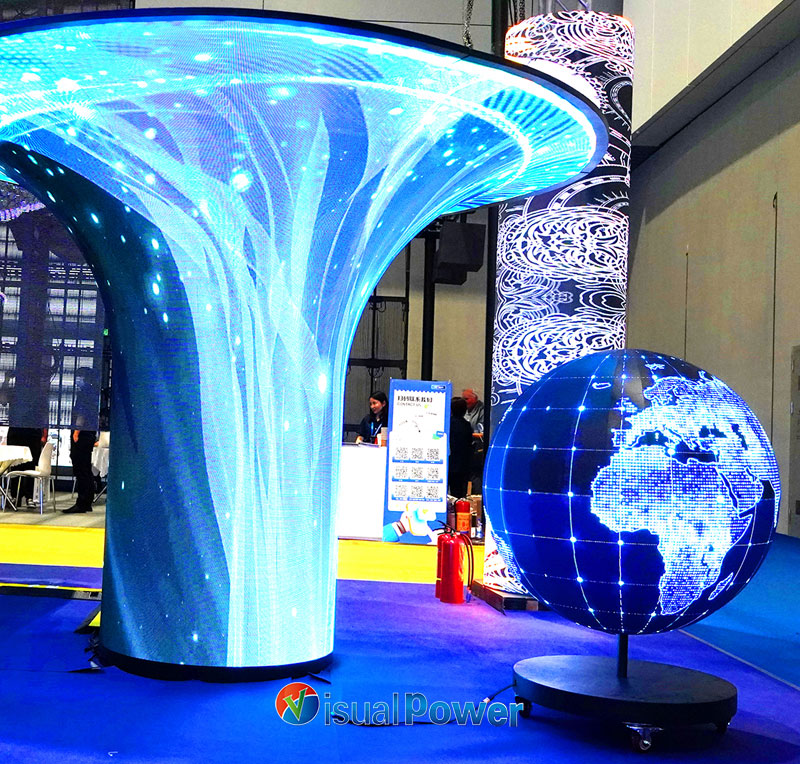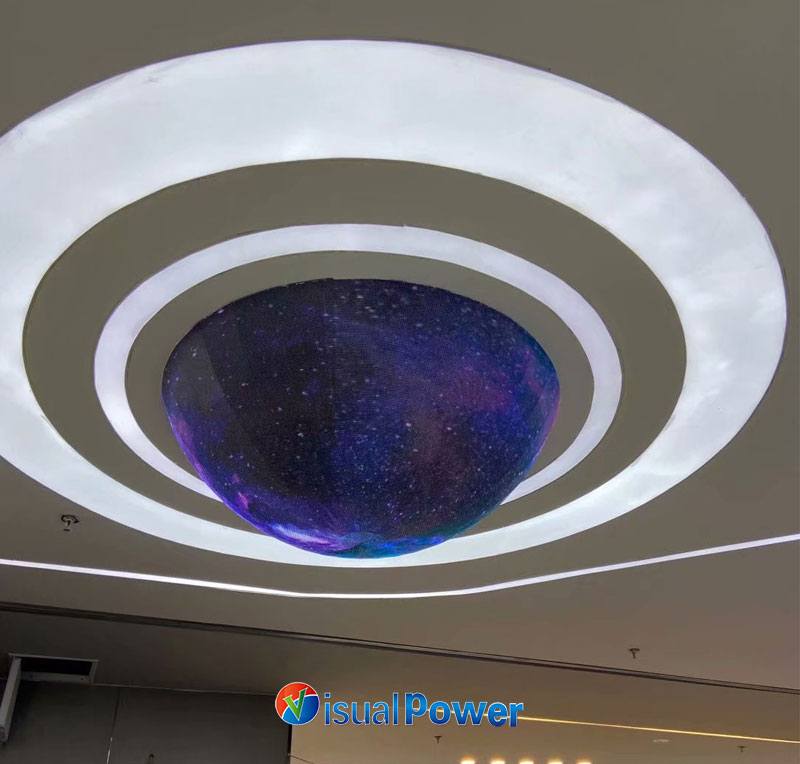Categories
- News (75)
- case study (6)
The first time I came across a “spherical” LED display screen was in an unremarkable exhibition hall in Shenzhen. There was no elaborate decoration, nor a bustling crowd. It was just a quietly rotating luminous object in the corner. But I literally stopped in my tracks — it wasn’t a screen; it was more like an installation art. At that moment, I realized that the era of traditional flat display might be gradually giving way to a more three-dimensional and immersive way of expression.

It’s not just a “curved” screen. These irregular-shaped LEDs go far beyond traditional flat formats: they can be spherical, cubic, hexagonal, wavy, ring-shaped, or even zigzag structures suspended in the air. It is not used to view “content”, but together with the space, constitutes the content itself.
This type of display device is usually composed of flexible modules spliced together, supporting free bending, twisting, and even 360-degree three-dimensional assembly, breaking the traditional impression that LEDs can only be “attached to the wall”. Its true charm lies not only in its form but also in the ability of “spatial narrative” it brings.
Over the past two years, I have been involved in many cross-industry projects, ranging from museums to technology exhibitions, from airports to commercial complexes. One thing is crystal clear — brands are no longer content with merely “playing content”; they aim to “create venues”.
To put it more straightforwardly: The time that an ordinary LED large screen can capture the audience’s attention might be 8 seconds. But something truly unconventional can hold them for five full minutes. A suspended triangular prismatic display device enables the audience to take photos, discuss and even stop for five minutes.
This is not showing off skills; it’s a reshaping of visual logic.
When I was working at an architectural firm in Singapore, I witnessed the process of them creating a “data flow” in the atrium of the office building with spiral LEDs — it was no longer a one-way communication, but became a part of the corporate culture, being passed through by employees and visitors every day.

1、Immersive art exhibition × Digital installation
I participated in an exhibition project and used a modular LED component from Visual power to create a “breathing digital dome”. It can sense the speed at which the audience approaches, adjust the rhythm of the picture, and truly make people feel “surrounded by technology”, without the slightest sense of oppression.
2、Urban Space × Architectural Integration
In the Tianhe business district of Guangzhou, an LED “water drop” structural device has been integrated into the atrium of a landmark building. It’s not just decoration — it actively guides foot traffic. It not only plays information but also becomes part of natural traffic diversion. Using irregular-shaped screens as navigation entry points is more than twice as efficient as traditional signboards.
3、Exhibition and flash mob × Strong memory point manufacturing machine
At an overseas auto show, my team designed a set of rotating cube screens that combined vehicle introductions with interactive lighting. The popularity of that screen taking photos directly made it to the front pages of the local mainstream social media. The brand said nothing — they just put this “special shape” there.
The technical difficulties are not limited to the shape
Of course, it can’t just be said to be “cool”. The challenges of irregular-shaped LEDs aren’t just aesthetic — they’re deeply technical: structural design, circuit path, module adaptation, viewing angle error, pixel allocation of the played content, heat dissipation and ventilation, and later maintenance… Each item may “drag down” the project.
Especially in content production — making a video for a spherical screen is not simply about “cropping” the rounded corners, but rather considering the relationship between each surface and the viewer’s perspective. If the content is not well done, what users see will no longer be “shocking”, but “dazzling”.
But once overcome, what it presents is a “spatial memory” that linear screens can never replace.

I believe that these “alien forms” will soon become part of our everyday landscape. Not every place needs to have spherical screens, but in the future, there will definitely be more space that no longer takes “rectangles” as the basic unit. The screen becomes the structure itself, information becomes part of the building, and emotions are disseminated through the structure.
Visual power is currently delving quite deeply into this path. I have witnessed with my own eyes that their display modules have played a key role in multiple projects. And I believe that the next step will not only be a breakthrough in shape, but also include sensor interaction, data visualization-driven, and even the fusion of AI-generated images and structures.
The true value of irregular-shaped LEDs does not lie in showing off technical skills, but in their ability to enable information expression to evolve from two-dimensional to three-dimensional or even four-dimensional (including time and interaction).
This is not about “being a little more curved than others”, but rather the beginning of a complete departure from flat-screen thinking.